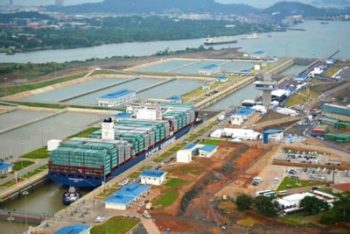
On 1 June the Panama Canal Authority [ACP] published a proposal to modify its current tolls structure.
This marks the beginning of the usual 30-day formal consultation period for industry feedback, allowing the waterway to continue providing a competitive service to its customers, the ACP said.
Panama Canal Administrator Jorge L. Quijano and executives in the past few months have met with Canal customers and industry representatives in Europe, Asia and North America.
“These meetings with customers in Asia, Europe and North America have been extremely valuable in providing us with a deeper understanding of the industry today, the challenges faced by individual market segments, and the projected demand for the neo-panamax locks,” said Quijano.
Almost a year after the inauguration of the new set of locks 29 June 2016, and after a thorough analysis of the feedback obtained during these meetings, and the current utilisation and productivity of the neo-panamax locks, the ACP considered it was necessary to provide additional incentives to the containership segment—the largest user of the expanded Canal—revise the tolls for liquefied petroleum gas (LPG) and liquefied natural gas (LNG) vessels, and reclassify container/breakbulk vessels.
The modifications were approved by the ACP’s Board of Directors on 25 May 2017.
The last modification to the tolls structure was implemented in April 2016 and applicable to all vessels transiting the waterway whether in the original or the new locks.
“The proposed modifications safeguard the competitiveness of the waterway, the value of the route, and facilitates the Canal’s goal of providing an efficient and reliable service to the global shipping community,” added Quijano.
For the containership segment, the proposal offers more attractive rates per loaded containers on the return voyage, applicable only to neopanamax vessels deployed on the Canal route in the head and back haul legs, and when the utilisation rate of the northbound transit is higher or equal to 70%, and the time lapse between the northbound and the southbound transit is not greater than 25 days.
In order to promote the use of the services provided by the local transportation hub, any additional days that the vessel requires to perform port-related activities in the Panamanian terminals will not add to the 25-day period.
The proposal also modifies the tolls charged to LPG and LNG vessels, but keeps the units of measurement unchanged, as they have proven to be in accordance with industry standards. In addition, this tolls proposal reassigns the vessels classified by the ACP as “container/breakbulk” into the “general cargo segment.” These vessels are currently part of the “other segments.”
This reassignment will result in more attractive tariffs for customers in this category, as general cargo tolls are lower. This change is made in response to a request submitted by customers during the 2015 tolls hearing and consultation process, and due to the fact that container/breakbulk vessels operate in a manner similar to that of general cargo vessels.
Copyright Ships & Ports Ltd. Permission to use quotations from this article is granted subject to appropriate credit given to www.shipsandports.com.ng as the source.